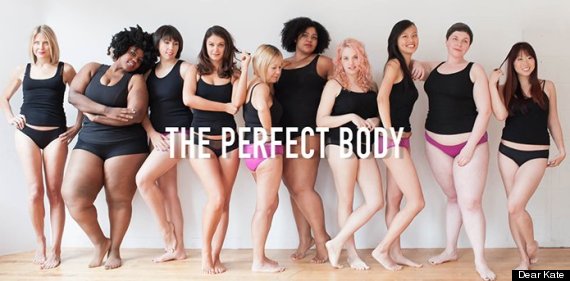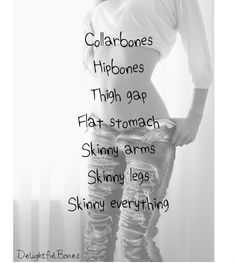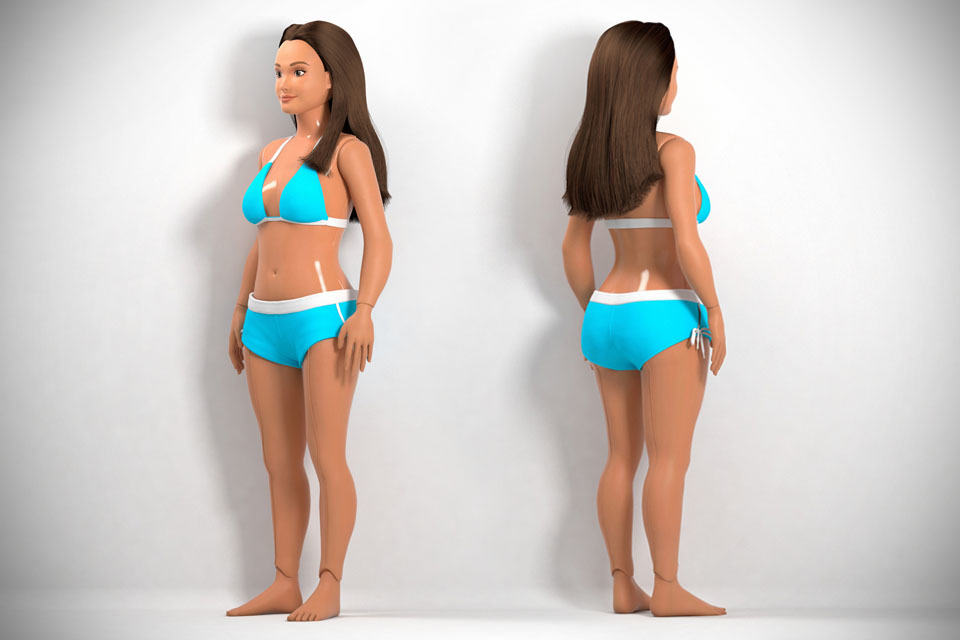
First of all, there are many different types of eating disorders. The most common one is anorexia nervosa, or just anorexia for short. It mostly occurs in teenage girls who often think they are ‘overweight’ and ‘obese’. They will become fixated on becoming thin in ways such as self-starvation, self-abuse, and obsessive exercising routines. The second type is bulimia nervosa, from the Greek word boulimia, which means ‘great hunger’. People with bulimia would gorge food, followed by forced vomiting. Both eating disorder victims are trying to achieve bony, fatless, bodies amongst themselves.
On many fashion magazines and ‘thinspiration’ websites, there will be numerous pictures of unattainable body types on many fashion models and unhealthy weights that are marked ‘pretty’. These will often become inspirations for young teenagers to want to become thin and ‘pretty’. If not by the pictures the media sends out, low self-esteem, anxiety, depression, victims of bullying, or girls with ‘perfectionist’ personalities can also be the main causes. These teenagers will always try to fit in by wanting to become thin and start dieting. Since anorexia is largely psychological, many become starved to death because of anorexia nervosa or, for the lucky ones, are found out and able to seek help from psychologists.





Barbie dolls are considered a ‘must have’ in a little girl’s life, but these thoughts of having ‘beautiful’ body shapes similar to Barbie’s is not possible. Statistics show that a girl would usually have her first barbie by the age of three, and will collect a total of seven dolls during her childhood. Barbie dolls are often blamed for eating disorders that have developed later on in a child’s life. These dolls with fictionally proportioned body sizes have since been planted in many little girls’ young minds that give them the concept that being thin equates to happiness. We can prove that having barbie body shapes are impossible because if barbie was a real person, she would stand to be six feet tall, with a 39” bust, 18” waist, 33” hips, and would wear a size 3 shoe. She would also weigh 110 lbs and have a BMI of 16.24, thus fit in the weight criteria for being anorexic. Due to her weight, Barbie would most likely not menstruate. She would also have to walk on all fours due to her proportions. Is this what the American toy-company Mattel, Inc. wants to send out to young ladies out there who buy their barbie dolls?
However, many also say that these eating disorders were not just influenced by the media, but by many other different factors; that the media influences are not a direct cause. Early childhood development builds up the child’s self-esteem as he/she grows, but as the obesity numbers of children around the world continue to increase, many parents belittle their child’s little minds by manipulating over their intake of foods and controlling their body appearances. These can set problems along the lines of the child’s growth.
Genetics in the family can also play a big role in whether the child would or wouldn't have an eating disorder. A research led by Dr. Michael Strober at the Neuropsychiatric Institute of the University of California, Los Angeles (UCLA), proves that an individual is twelve times more likely to develop anorexia if a close relative has also suffered from the disorder, and four times more likely to develop bulimia.
Going back to the barbie doll factor, many artistic and enthusiastic young men and women are fighting the idea of ‘thin is beauty’. Nickolay Lamm, an artist known online for his digital visualizations, took measurements of average American women and compared them with the normal barbie doll. He decided to make a barbie doll that would better off represent a healthy, ordinary body type. Lamm’s collaborating campaign for Lammily, the average barbie doll, is now up and running. He hopes to produce 5,000 dolls. Nickolay Lamm wants to bring out to young boys and girls that average is also beautiful.

Healthy Barbie Doll: Lammily
In conclusion, eating disorders are a very serious factor amongst 7.046 billion people in the world. This can be caused by both the photos that the media sends out or by the genes that have passed on from earlier generations. Which are they caused by? Well, I myself would not be able to answer this question. On the good side, we can at least try to prevent this by stopping the media from telling all their models that they are ‘overweight’ and ‘not fit’ to be photographed. If this was taken into action, the number of eating disorders would most likely drop immensely.
References:
Fettner, Ann Guidici. “Britannica School/ anorexia nervosa”. 17 March, 2014. School Database. http://school.ebonline.com/levels/middle/article/272888
Ballaro, Beverly. Wagner, Geraldine. “Body Image & the Media: An Overview”. 10 March, 2014. School Database. http://web.b.ebscohost.com/pov/detail?sid=e1bb71b6-9958-4e13-8896dfd90ef40b10%40sessionmgr112&vid=2&hid=103&bdata=JnNpdGU9cG92LWxpdmU%3d#db=pwh&AN=28675178
Maine, Margo. “Get Real Barbie” Fact Sheet*”. 17 March, 2014. PDF. http://www.chapman.edu/students/health-and-safety/psychological-counseling/_files/eating-disorder-files/13-barbie-facts.pdf
Lamm, Nickolay. “Lammily- Average is Beautiful”. 17 March, 2014. Website.
https://www.lammily.com/average-is-beautiful
Driscoll, Sally, Campbell, Tamara. “Counterpoint: Body Image is Influenced by Many Factors, not Just the Media”. 20 March, 2014. School Database.
http://web.b.ebscohost.com/pov/detail?sid=c578a509-1ff1-4ecf-a1f7-7ed4964f350f%40sessionmgr114&vid=2&hid=128
No comments:
Post a Comment